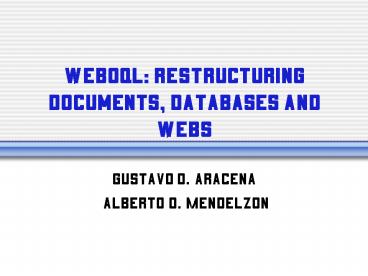WebOQL: Restructuring Documents, Databases and Webs - PowerPoint PPT Presentation
1 / 10
Title:
WebOQL: Restructuring Documents, Databases and Webs
Description:
WebOQL: Restructuring Documents, Databases and Webs. Gustavo O. Aracena. Alberto O. Mendelzon ... Restructuring Documents. Navigational patterns ... – PowerPoint PPT presentation
Number of Views:137
Avg rating:3.0/5.0
Title: WebOQL: Restructuring Documents, Databases and Webs
1
WebOQL Restructuring Documents, Databases and
Webs
- Gustavo O. Aracena
- Alberto O. Mendelzon
2
Background
- Background
- widespread use of Web
- new data management problems
- What is WebOQL?
- combination of architecture, data model and query
language on which we would be able to extract
information from online structured documents
effectively withouth custom-tailored programs
3
Data Model
- Tree-based data model
- hypertree ordered arc-labeled trees
- arcs internal and external
- internal arcs are used to represent structured
objects - external arcs are used to represent references
among object - external arcs cannot have descendants
- external arcs must have a field named Url
- Hypertrees are useful because they subsume three
abstractions collections, nesting, and ordering
4
Data Model
- Web
- a pair(t, F) consisting hypertree t and a
function F that maps URLs to hypertrees - t is the schema
- F is the browsing function of the web
- Tails
- Tails of trees of t obtained by chopping off
prefixes of t - Simple trees
- Simple trees of t are the trees composed of one
arc followed by a tree that stems from ts root - Subtrees
- subtrees of tree t are the trees at the end of
the arcs that stem from ts root
5
Data Model
- Operators
- Prime operator () returns the first subtree of
its argument - Peek operator (.) extracts a field from the
record that labels the first outgoing arcs of its
argument - Hang operator () builds an arc labeled with a
record formed with the arguments - Tilda () is used for string matching pattern
- Concatenate () to juxtapose two trees
- Head ( n) returns the first n simple trees of a
tree (n gt0) - Tail (!) returns all but the first simple tree of
a tree
6
Operators
7
Query
- Input of query in WebOQL URL deferencing
- URL deferencing means replacing URL with the
result of applyting the browsing function of the
current web to it - Web restructuring query
- a function that maps a web into another
- example
- this select y.Title, y.Url as schema
- from x in csPapers, y in x
- where y.Authors Smith
- generalization
- select q1 as s1, q2 as s2, , qm as sm
- qi are queries
- si is either a string query or the keyword schema
8
Restructuring Web
9
Structured Documents
- Structured documents modeled as abstract syntax
trees (AST) - Each arc in AST corresponds either to a
subdocument enclosed in an occurrence of a paired
tag, to a nonpaired tag, or to a piece on an
untagged text
10
Restructuring Documents
- Navigational patterns
- regular expressions over an alphabet of record
predicates - Tail variables
- iterate over tails, instead of simple trees
- indicated by capital letter
- example
- Tag OL /
- select Tag LI / X3
- from X in browse(Card Punching.html)!
- where X.Tag H3































